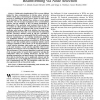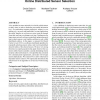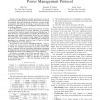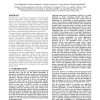198 search results - page 35 / 40 » Interference power statistics in ad-hoc and sensor networks |
JNW
2008
13 years 9 months ago
2008
Wearable physiological monitoring system consists of an array of sensors embedded into the fabric of the wearer to continuously monitor the physiological parameters and transmit wi...
CORR
2010
Springer
13 years 10 months ago
2010
Springer
Collaborative beamforming (CB) is a power efficient method for data communications in wireless sensor networks (WSNs) which aims at increasing the transmission range in the network...
IPSN
2010
Springer
14 years 4 months ago
2010
Springer
A key problem in sensor networks is to decide which sensors to query when, in order to obtain the most useful information (e.g., for performing accurate prediction), subject to co...
ICNP
2006
IEEE
14 years 3 months ago
2006
IEEE
— Energy efficiency is widely understood to be one of the dominant considerations for Wireless Sensor Networks. Based on historical data and technology trends, the receiver ener...
DATE
2007
IEEE
14 years 4 months ago
2007
IEEE
In highly power constrained sensor networks, harvesting energy from the environment makes prolonged or even perpetual execution feasible. In such energy harvesting systems, energy...




